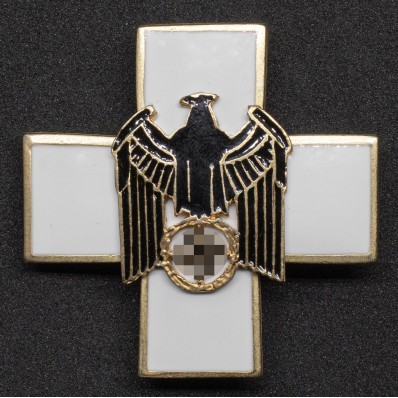No products
Product successfully added to your shopping cart
There are 0 items in your cart. There is 1 item in your cart.
Social Welfare Decoration 2nd Class
New
The Social Welfare Decoration (Ehrenzeichen für deutsche Volkspflege), established on 1 May 1939, honored services in the social and humanitarian field, replacing the German Red Cross Decoration. Awarded to both Germans and foreigners, it had four classes plus a medal, recognizing work in welfare, medical aid, rescue services, or support for ethnic Germans.
- Satisfied or refunded: we guarantee 100% secure protection on your purchases
- Free return: return your order free of charge within 30 days from receipt
- Secure payments: pay securely online with PayPal or credit cards

More info
The Social Welfare Decoration (Ehrenzeichen für deutsche Volkspflege) was founded on 1 May 1939 by Adolf Hitler to recognize exceptional service in public welfare, the Winter Relief program, medical care of the sick and wounded in peace or war, rescue operations, the preservation of German culture, and support for ethnic Germans abroad. It replaced the German Red Cross Decoration and could be awarded to both Germans and foreigners.
The order consisted of four main classes plus a medal, with a special star grade as the highest distinction:
Special Class: a four-rayed breast star worn on a sash over the right shoulder
1st Class: a 52 mm white-enamelled cross worn around the neck
2nd Class: a 52 mm pin cross (Steckkreuz), worn on the left breast
3rd Class: a 40 mm cross on a red ribbon with white edges, worn on the chest
Medal for Social Welfare: a 38 mm round silvered medal in bronze or zinc, showing the cross on the obverse and the inscription Medaille für deutsche Volkspflege on the reverse
From 30 January 1942, the 3rd Class and Medal could be awarded with crossed swords for merit during wartime.
The design by Professor Richard Klein featured a white enamelled Balkenkreuz edged in gold, with the black Reich eagle holding an inverted swastika surrounded by a golden oak wreath at the center. Higher classes had enamelled backs, while the 3rd class and medal were plain metal.
Recipients were required to return lower grades upon receiving a higher one, while after death the decoration remained with the family as a keepsake.
Data sheet
| Width | 45.5 mm |
| Lenght | 45.5 mm |
| Thickness | 2.40 mm |
| Weight | 19.4 gr |
| Material | Zamak, Iron, Brass, Enamels |
Brooch Medals
- Germany
- Medals, Orders and Decorations
- Badges and Pins
- ID Tags
- Arm Shields
- Visor Caps and Hats
- Cap and Helmet Badges
- Collar Tabs Cyphers
- Collar Tabs, Shoulder Boards and Epaulettes
- Arm Bands
- Division Cuff Titles
- Buckles And Belts
- Buttons For Uniforms
- Stamps
- Gorgets
- Rings
- SS Honour Ring in 925 Silver - Collector's Set
- Poletops
- Flags
- Daggers and Knives (Ornamental)
- Field Marshal Batons
- Ammo Pouches, Bandoliers and Bags
- Service Watches
- Presentation Cases
- Documents and Award Letters
- Busts, Eagles, Lighters and Miscellaneous
- Croatian and Ustasha Militaria
- Denazified Articles
- Commemorative Necklaces
- Spare Parts, Small Parts and Accessories
- Italy
- Medals and Decorations
- Brevets And Badges
- Battle Shields and Tags
- Gorgets
- Visor Caps and Hats
- Cap and Helmet Badges
- Friezes for Collar Tabs
- Collar Tabs, Shoulder Boards and Epaulettes
- Buckles
- Belts
- Buttons For Uniforms
- Rings
- Poletops
- Italian Resistance
- Keyrings
- Wallshields
- Daggers and Knives
- Flags
- Busts and Eagles
- Souvenirs
- Commemorative Necklaces
- Imperial Germany
- Soviet Union
- Other Countries






